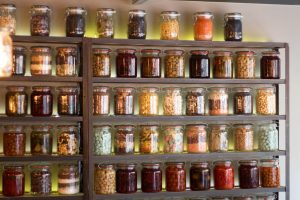Did you know that the food you consume and throw away plays a big role in the health of our environment? Learn how Meal Mapping can be a part of the solution when it comes to preserving the environment and eliminating food waste.

Does that all seem overwhelming? Yes, of course it does, but the encouraging news is that your actions can help prevent this huge strain on our environment, health and general well-being. It’s as simple as doing your best to reduce food waste. On a large scale, food waste happens in almost every sector of the food chain. Much of that is out of your control. What is in your control is the food you buy and the food you consume. It’s time for you to identify ways you can make changes and the following ideas can help get you started:
Start Meal Mapping
That’s right, planning your meals is one of the biggest tools you have to prevent food waste. When you plan your meals, you’re essentially setting up a game plan to reduce the food you waste. Think about it. You buy the foods you need for the week, each one accounted for in it’s respective recipe, and then you consume them according to the map you’ve created. When you stick to your meal map, you’ll begin to notice the difference in the foods you’ve saved from the trash can!
Practice Smart Food Placement
Ever notice how some foods seem to lurk in the back of your refrigerator? They’re the ones that you don’t pay much attention to until it’s too late. Take a clue from restaurants and practice First In, First Out (or FIFO). How does it work? Place your newly purchased foods to the back of the fridge and pantry so that the older foods are in front. Once the older foods are in front, you’ll see them which helps you remember to consume them before they spoil.
Label and Date Your Food
This one is simple. Buy yourself a permanent marker and every time you open a new container of something, mark the container with the date you opened it. Same goes for leftovers, before storing them, clearly label what’s in the container and the date you prepared it. This way you’ll know exactly how old something is and where it belongs in your refrigerator/pantry (see Practice Smart Food Placement above).
Use Your Freezer
It may sound like a no-brainer, but your freezer can be an especially handy tool when it comes to preventing food waste. Many foods freeze remarkably well, so it’s worth stashing them there if you know you can’t consume them before they go bad. Don’t forget to label and date them before you store them and be sure to use freezer-safe containers to prevent freezer burn.
Now you’ve got four powerful tools to help you fight the good fight when it comes to food waste. And luckily for you, each one is simple to execute, requiring very little time or effort on your part. Don’t continue adding to that $165 billion dollars of food that will never get consumed. Instead, make a pact with yourself this very moment to start doing your part when it comes to preventing food waste.
Resources:
- http://www.nrdc.org/food/files/waste-food-ip.pdf. Published August 2012. Accessed March 17 2016.
- Food Loss and Food Waste, Food and Agriculture Organization of the United Nations. http://www.fao.org/food-loss-and-food-waste/en/. Accessed March 17 2016.
- Brown, Katie and Vogliano, Chris. State of America’s Wasted Food. Academy of Nutrition and Dietetics Foundation. 2016.
Find it here: http://www.eatrightfoundation.org/foundation/futureoffood/
Sara Haas is a registered dietitian nutritionist (RDN) based in Chicago, Illinois. She works primarily as a freelance consultant dietitian and chef, and writes on her own blog at www.sarahaasrdn.com. She’s been helping people for almost 15 years to understand the importance of nutrition on health and well-being. She can be seen on television doing cooking segments, or on the radio lending her voice for nutrition-related PSA’s, or even in some of your favorite publications giving tips on nutrition.
We’re thankful to have Sara answering nutrition questions here on the Plan to Eat blog. Send your questions to Sara by filling out this short form.






